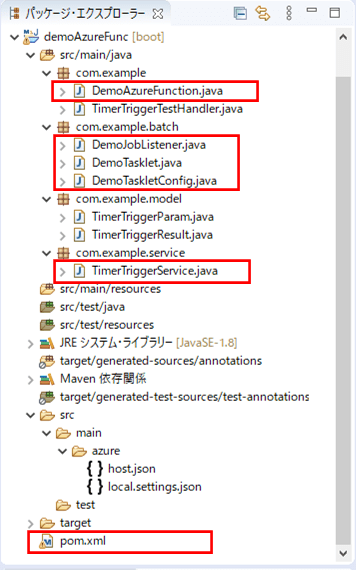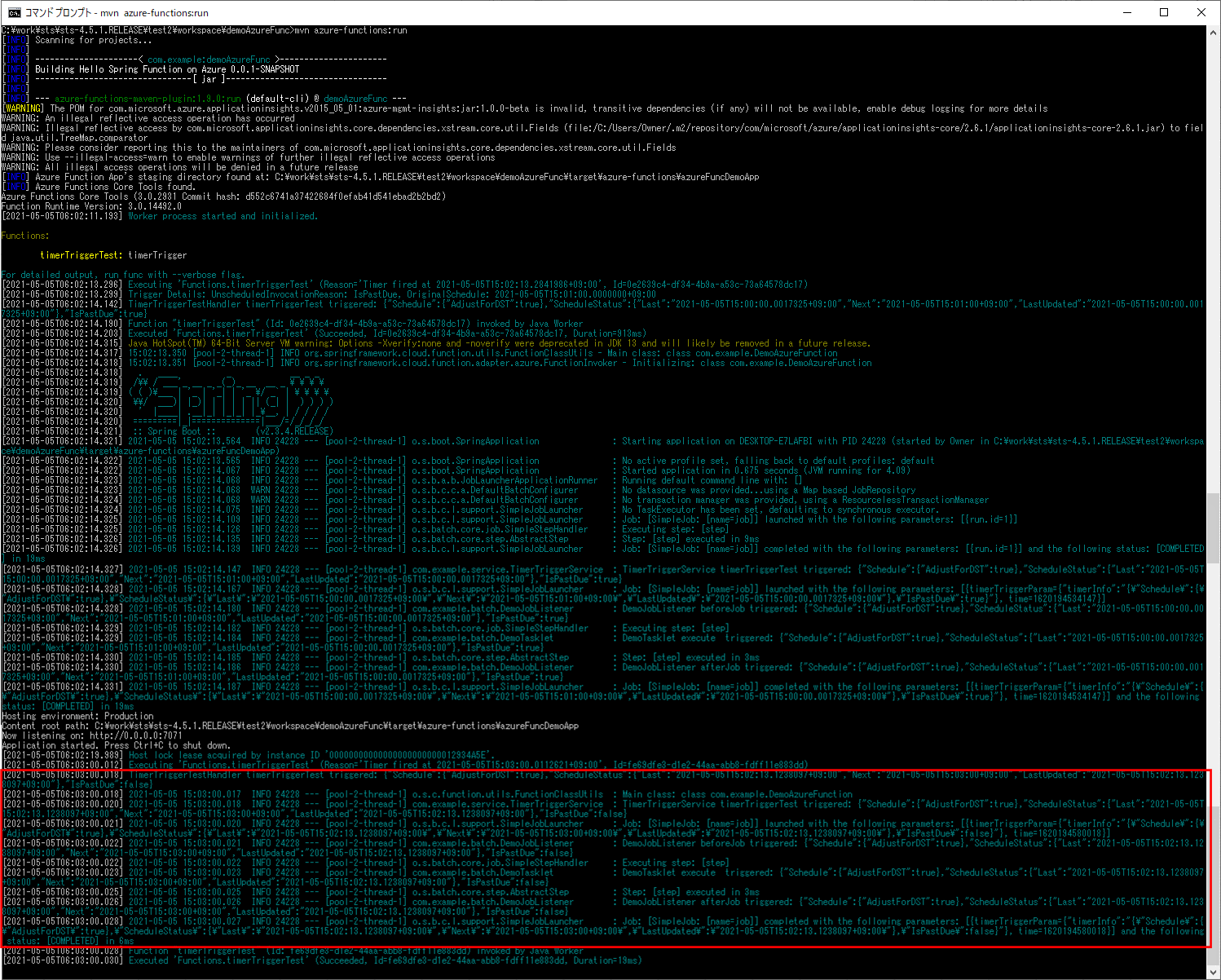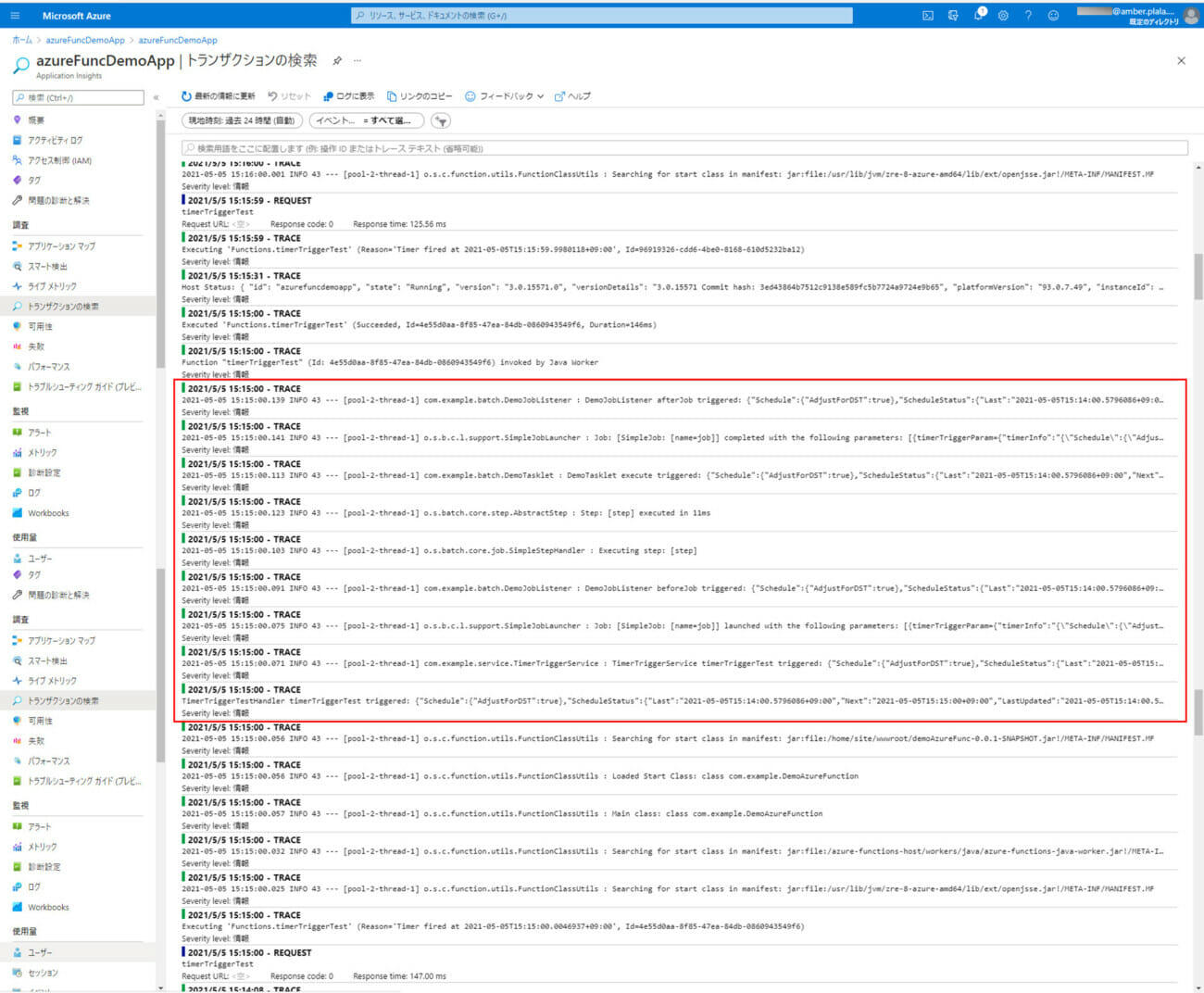Timer Triggerによって、一定時間が来たタイミングでAzure Functionsが動作するアプリケーションを生成できるが、そのバッチ処理内部で、Spring Batchを利用することもできる。
今回は、Azure Functions上でTimerTriggerによって動作するJavaアプリケーション(Spring Boot上)でSpring Batchを利用してみたので、そのサンプルプログラムを共有する。
なお、Spring BatchにはChunkモデルとTaskletモデルがあるが、今回はTaskletモデルを利用している。Spring Batchのアーキテクチャについては、以下のサイトを参照のこと。
https://terasoluna-batch.github.io/guideline/5.0.0.RELEASE/ja/Ch02_SpringBatchArchitecture.html
前提条件
下記記事のサンプルプログラムを作成済であること。

作成したサンプルプログラムの修正
前提条件の記事のサンプルプログラムに、Spring Batchの処理を追加する。なお、下記の赤枠は、前提条件のプログラムから大きく変更したり、追加したりしたプログラムである。

pom.xmlへの追加内容は以下の通りで、Spring Batchを利用するためのライブラリを追加している。
<!-- Spring Batchを利用するための設定 -->
<dependency>
<groupId>org.springframework.boot</groupId>
<artifactId>spring-boot-starter-batch</artifactId>
</dependency>また、メインクラスの内容は以下の通りで、Spring Batch内で行われるデータソースの自動設定を除外している。
package com.example;
import java.util.function.Function;
import org.springframework.beans.factory.annotation.Autowired;
import org.springframework.boot.SpringApplication;
import org.springframework.boot.autoconfigure.SpringBootApplication;
import org.springframework.boot.autoconfigure.jdbc.DataSourceAutoConfiguration;
import org.springframework.context.annotation.Bean;
import com.example.model.TimerTriggerParam;
import com.example.model.TimerTriggerResult;
import com.example.service.TimerTriggerService;
//Spring Batchを利用するが、今回はDBを使わないため、データソースの自動設定を除外する
@SpringBootApplication(exclude = { DataSourceAutoConfiguration.class })
public class DemoAzureFunction {
/** タイマートリガーのテストを行うサービスクラスのオブジェクト */
@Autowired
private TimerTriggerService timerTriggerService;
public static void main(String[] args) throws Exception {
SpringApplication.run(DemoAzureFunction.class, args);
}
/**
* タイマートリガーのテストを行い結果を返却する関数
* @return タイマートリガーのテストを行うサービスクラスの呼出結果
*/
@Bean
public Function<TimerTriggerParam, TimerTriggerResult> timerTriggerTest(){
return timerTriggerParam
-> timerTriggerService.timerTriggerTest(timerTriggerParam);
}
}さらに、サービスクラスの内容は以下の通りで、Spring Batchのジョブを起動する設定を追加している。
package com.example.service;
import java.util.HashMap;
import java.util.Map;
import org.slf4j.Logger;
import org.slf4j.LoggerFactory;
import org.springframework.batch.core.Job;
import org.springframework.batch.core.JobParameter;
import org.springframework.batch.core.JobParameters;
import org.springframework.batch.core.launch.JobLauncher;
import org.springframework.beans.factory.annotation.Autowired;
import org.springframework.stereotype.Service;
import com.example.model.TimerTriggerParam;
import com.example.model.TimerTriggerResult;
import com.fasterxml.jackson.core.JsonProcessingException;
import com.fasterxml.jackson.databind.ObjectMapper;
@Service
public class TimerTriggerService {
/* Spring Bootでログ出力するためのLogbackのクラスを生成 */
private static final Logger LOGGER
= LoggerFactory.getLogger(TimerTriggerService.class);
/** Spring Batchのジョブを起動するクラス */
@Autowired
JobLauncher jobLauncher;
/** Spring Batchのジョブを定義するクラス */
@Autowired
Job job;
/**
* タイマートリガーのテストを行うサービス.
* @param param TimerTrigger呼出用Param
* @return タイマートリガーのテストを行うサービスクラスの呼出結果
*/
public TimerTriggerResult timerTriggerTest(TimerTriggerParam param) {
// タイマートリガーのテストを行うサービスが呼び出されたことをログ出力する
LOGGER.info("TimerTriggerService timerTriggerTest triggered: "
+ param.getTimerInfo());
// Spring Batchのジョブを起動する
// ジョブ起動時に生成したパラメータを指定する
try {
jobLauncher.run(job, createInitialJobParameterMap(param));
} catch (Exception e) {
throw new RuntimeException(e);
}
// タイマートリガーのテストを行うサービスクラスの呼出結果を返却する
TimerTriggerResult result = new TimerTriggerResult();
result.setResult("success");
return result;
}
/**
* ジョブを起動するためのパラメータを生成する.
* @param TimerTriggerParamオブジェクト
* @return ジョブを起動するためのパラメータ
* @throws JsonProcessingException
*/
private JobParameters createInitialJobParameterMap(TimerTriggerParam param)
throws JsonProcessingException {
Map<String, JobParameter> m = new HashMap<>();
m.put("time", new JobParameter(System.currentTimeMillis()));
m.put("timerTriggerParam"
, new JobParameter(new ObjectMapper().writeValueAsString(param)));
JobParameters p = new JobParameters(m);
return p;
}
}
また、Spring Batchの起動定義は以下の通りで、バッチジョブに処理(Tasklet)とその前後処理(Listener)を追加している。
package com.example.batch;
import org.springframework.batch.core.Job;
import org.springframework.batch.core.Step;
import org.springframework.batch.core.configuration.annotation.EnableBatchProcessing;
import org.springframework.batch.core.configuration.annotation.JobBuilderFactory;
import org.springframework.batch.core.configuration.annotation.StepBuilderFactory;
import org.springframework.batch.core.launch.support.RunIdIncrementer;
import org.springframework.beans.factory.annotation.Autowired;
import org.springframework.context.annotation.Bean;
import org.springframework.context.annotation.Configuration;
@Configuration
@EnableBatchProcessing
public class DemoTaskletConfig {
/** Spring Batchのジョブ内で指定する実行処理を定義するクラス */
@Autowired
private DemoTasklet demoTasklet;
/** Spring Batchのジョブを生成するクラス */
@Autowired
private JobBuilderFactory jobBuilderFactory;
/** Spring Batchのステップを生成するクラス */
@Autowired
private StepBuilderFactory stepBuilderFactory;
/**
* Spring Batchのジョブ内で指定する処理単位(ステップ)を定義する.
* @return Spring Batchのジョブ内で指定する処理単位
*/
@Bean
public Step step() {
// 生成するステップ内で実行処理(Tasklet)を指定する
return stepBuilderFactory.get("step")
.tasklet(demoTasklet)
.build();
}
/**
* Spring Batchのジョブを定義する.
* @param step1 実行するステップ
* @return Spring Batchのジョブ
*/
@Bean
public Job job(Step step) {
// 生成するジョブ内で、実行前後の処理(リスナ)と処理単位(ステップ)を指定する
return jobBuilderFactory.get("job")
.incrementer(new RunIdIncrementer())
.listener(listener())
.start(step)
.build();
}
/**
* Spring Batchのジョブの実行前後の処理を定義する.
* @return Spring Batchのジョブの実行前後の処理
*/
@Bean
public DemoJobListener listener() {
return new DemoJobListener();
}
}さらに、Spring Batchのジョブ内での処理(Tasklet)を定義しているクラスの内容は、以下の通り。
package com.example.batch;
import org.slf4j.Logger;
import org.slf4j.LoggerFactory;
import org.springframework.batch.core.StepContribution;
import org.springframework.batch.core.scope.context.ChunkContext;
import org.springframework.batch.repeat.RepeatStatus;
import org.springframework.stereotype.Component;
import com.example.model.TimerTriggerParam;
import com.fasterxml.jackson.core.type.TypeReference;
import com.fasterxml.jackson.databind.ObjectMapper;
import org.springframework.batch.core.step.tasklet.Tasklet;
@Component
public class DemoTasklet implements Tasklet {
/* Spring Bootでログ出力するためのLogbackのクラスを生成 */
private static final Logger LOGGER
= LoggerFactory.getLogger(DemoTasklet.class);
/**
* Spring Batchのジョブ内での処理を定義する.
*/
@Override
public RepeatStatus execute(StepContribution contribution
, ChunkContext chunkContext) throws Exception {
// Spring Batchのジョブ内での処理が呼び出されたことをログ出力する
String paramStr = chunkContext.getStepContext()
.getStepExecution().getJobParameters()
.getString("timerTriggerParam");
if(paramStr != null) {
TimerTriggerParam param = new ObjectMapper().readValue(
paramStr, new TypeReference<TimerTriggerParam>() {});
LOGGER.info("DemoTasklet execute " + " triggered: "
+ param.getTimerInfo());
}
return RepeatStatus.FINISHED;
}
}
また、Spring Batchのジョブの前後で実施する処理(Listener)を定義を定義しているクラスの内容は、以下の通り。
package com.example.batch;
import org.slf4j.Logger;
import org.slf4j.LoggerFactory;
import org.springframework.batch.core.JobExecution;
import org.springframework.batch.core.listener.JobExecutionListenerSupport;
import com.example.model.TimerTriggerParam;
import com.fasterxml.jackson.core.type.TypeReference;
import com.fasterxml.jackson.databind.ObjectMapper;
public class DemoJobListener extends JobExecutionListenerSupport {
/* Spring Bootでログ出力するためのLogbackのクラスを生成 */
private static final Logger LOGGER
= LoggerFactory.getLogger(DemoJobListener.class);
/**
* Spring Batchのジョブ実行前の処理を定義する.
*/
@Override
public void beforeJob(JobExecution jobExecution) {
super.beforeJob(jobExecution);
// Spring Batchのジョブ実行前の処理が呼び出されたことをログ出力する
printLog(jobExecution, "beforeJob");
}
/**
* Spring Batchのジョブ実行後の処理を定義する.
*/
@Override
public void afterJob(JobExecution jobExecution) {
super.afterJob(jobExecution);
// Spring Batchのジョブ実行後の処理が呼び出されたことをログ出力する
printLog(jobExecution, "afterJob");
}
/**
* ログ出力を行う.
* @param jobExecution ジョブ実行時の定義オブジェクト
* @param methodName メソッド名
*/
private void printLog(JobExecution jobExecution, String methodName) {
try {
String paramStr = jobExecution.getJobParameters()
.getString("timerTriggerParam");
if(paramStr != null) {
TimerTriggerParam param = new ObjectMapper().readValue(
paramStr, new TypeReference<TimerTriggerParam>() {});
LOGGER.info("DemoJobListener " + methodName + " triggered: "
+ param.getTimerInfo());
}
} catch (Exception e) {
throw new RuntimeException(e);
}
}
}その他のソースコード内容は、以下のサイトを参照のこと。ただし、TimerTriggerParamからLoggerのBean定義を削除している。
https://github.com/purin-it/azure/tree/master/azure-functions-spring-batch-tasklet/demoAzureFunc
また、その後のビルドとデプロイ手順については、前提条件の記事を参照のこと。
サンプルプログラムの実行結果(ローカル)
「mvn azure-functions:run」で実行した結果は以下の通りで、赤枠のログを確認すると、TimerTriggerTestHandler⇒TimerTriggerService⇒DemoJobListener⇒DemoTasklet の順に呼び出されることが確認できる。

サンプルプログラムの実行結果(Azure上)
サンプルプログラムを変更後、Application Insightsでログを確認した結果は以下の通りで、TimerTriggerTestHandler⇒TimerTriggerService⇒DemoJobListener⇒DemoTasklet の順に呼び出されることが確認できる。

なお、Application Insightsでのログ確認手順は、以下の記事の「サンプルプログラムの実行結果(Azure上)」の項番6以降を参照のこと。

要点まとめ
- TimerTriggerによって動作するAzure Function内のバッチ処理内部で、Spring Batchを利用することもできる。
- Spring BatchのTaskletモデルでは、処理(Tasklet)とその前後処理(Listener)からなるジョブを定義する。





